In today’s episode of Review Day Tuesday, I review issue #1 of the new Dark Horse title, Mulan: Revelations.
Here’s my question for you: Continue reading “Review Day Tuesday: Mulan Revelations”
In today’s episode of Review Day Tuesday, I review issue #1 of the new Dark Horse title, Mulan: Revelations.
Here’s my question for you: Continue reading “Review Day Tuesday: Mulan Revelations”
It’s another Review Day Tuesday video blog. Wheee!
In today’s review, I talk about In Real Life by Cory Doctorow & Jen Wang, and its take on economics and its effects on gamers.
If you’re interested in reading more things by Cory Doctorow, check out his Boing Boing page, and if you want to read more work by Jen Wang, read Koko Be Good and check out her website.
Let me know in the comments if you liked the review or, even better, what your thoughts were on the book!
Thank you for watching.
You. Are. Awesome.
Game Boss: The Final Form is an anthology I picked up at (surprise) Swarm Con.
Now, despite the title, not all of the stories within the anthology deal with video games. That may come as a surprise to you, because it sure surprised me.
As I read this, it occured to me that all of the stories, while not always dealing with video games, DID deal with a common theme: Transformation of the self, usually through a struggle, surprise, or sacrifice.
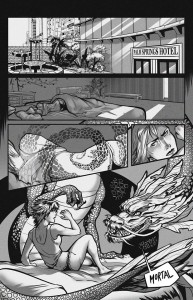
And to be fair…this anthology handles these themes very, very well.
There are too many stories for me to break this review down to review all of them, like I did with SIX. However, all the stories stand out for a variety of reasons.
The ones that stood out to me the most were “Flesh” by Lea Faske (pictured above), “No Parking” by Mad Rupert, and the first story that appears in the anthology, “Parting is Such Sweet Sorrow” by Ngozi Ukazu (fyi, she is the sweetest and coolest lady). These ones have the strongest art as well as the most interesting takes on the idea of “transformation,” ranging from straightforward shape shifting to transforming your world view to an emotional transformation through the sacrifice of another person.
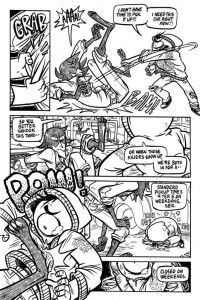
As for the art, that’s also varied. The art styles range from the hyper realism of Yunfan Zhou to the bold-lined, Steven Universe-esque cartooning in “The Quest” by Gerardo Alba. If you want some fantastic visual variety in your comics anthology, this is the volume that will satisfy you.
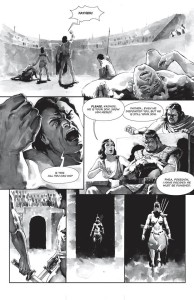
Have you read this anthology? What did you think about it? Let me know in the comments!
Thank you for reading.
You. Are. Awesome.
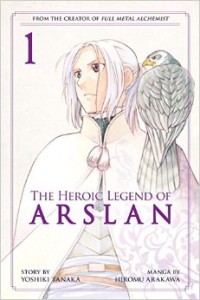
I love Hiromu Arakawa’s work. She’s one of my biggest inspirations in my comics-making career.
But I haven’t read much of her work outside of Fullmetal Alchemist and bits and pieces of a volume of A Hero’s Tale. I know. I bring shame upon my nerd head.
My friend Chloe, who is also a big fan of Arakawa’s, gifted me The Heroic Legend of Arslan (volumes 1 and 2) for Christmas. I heard Arakawa was working on this with a writer by the name of Yoshiki Tanaka, so I was super excited to read this.
I was thoroughly entertained.
Is it perfect? No. There are times where it feels like the characters are just throwing up exposition, but the action, the art, and the sincere characters really pull you through.
The story is about a prince named Arslan. He is the son of the war-hardened King Andragoras, who has never lost a battle. When Arslan reaches the age of 14, he rides into battle with his father against the Lusitanians, and I will stop there or else I would spoil it.
The first chapter of this manga was actually written by Arakawa, and takes place four years prior to the main events, to help give some context for the rest of the story. Don’t skip that chapter. It actually helps to give some wonderful insights into the character of Arslan, and is entertaining as hell.
One thing I noticed though, is the character designs.
In Arakawa’s work, she tends to use character designs that are similar across her work. To help clarify, take a look at Solf J. Kimblee from Fullmetal Alchemist, versus Marzban Daryun from Arslan.
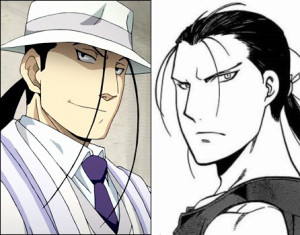
Now take a look at Armstrong from Fullmetal Alchemist and Eran Vahriz from Arslan.
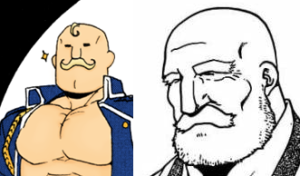
It’s Armstrong with a beard!
I think the reason behind this is that this references something done by one of the original manga masters, Osamu Tezuka. Tezuka took character designs across works like this because he was heavily influenced by movies. He saw the characters as actors, and he would have the actors take on new roles in various productions…or comics.
I think that’s what Arakawa does, as well. Her characters are actors taking on new roles. Is this an intentional homage? Or an art gag? Knowing Arakawa, it could be both.
Back to the manga, once you get into chapter 2, that’s when the warring and battles start. This is the real meat and potatoes of this first volume in the manga series. And it’s written and illustrated well. It’s not for the weak at heart, though, because it does feature a lot of impaling and catching people on fire.
You know, war.
Because of that, the characters (Arslan is a sweetie and Daryun is my all-time favorite), and the art, The Heroic Legend of Arslan is the rare story that has gotten me interested in manga again! I could not set this book down because I was so excited and eager to see what would happen next.
So if you’re tired of seeing the same old romantic-comedy manga on book shelves, give this series a try. It’s a breath of fresh air.
Thank you for reading, and I’ll see you tomorrow.
There’s a new addition to my comic collection thanks to the power of KickStarter…
I completely forgot I backed this project until it arrived in the mail, along with a really fun “Believe in Comics” sticker (which I already put on my sketchbook).
To be honest, this was the first horror comic I have ever purchased or read. I’m not usually a fan of horror. I don’t read horror comics and even horror movies are ones I watch sporadically. I’ve never seen many of the things this author draws inspiration from, like Tales from the Crypt.
The only horror films I have seen thus far are Psycho, The Birds, Orphan (which I would say is more a thriller than a horror film), and Shawn of the Dead.
Wait, zombie movies count. Then I’ve seen more horror than that.
But it wasn’t until I read this comic anthology, Six, that I was introduced to the idea that the horror genre had its own niches like atmospheric horror and supernatural horror.
So my mind was pretty much a blank slate in terms of expectations for this book.
And it’s actually good.
This anthology features stories written by one author, Fabian Rangel Jr, with different artists for each story.
The first short story, “The Blood and the Snow,” features a Conan the Barbarian-esque woman warrior fighting her way towards her arch nemesis. This one is still my favorite, but mostly because I have a soft spot for badass ladies (or else I wouldn’t have started the Women Warriors Project). The artist, Jonathan Brandon Sawyer, does a great job.
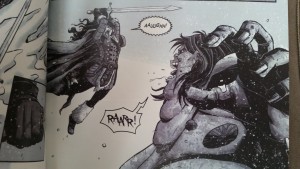
The second story, “The Souls of Wicked Men,” follows two train robbers who fail in their heist, and retreat into the woods for shelter. I’m not going to spoil the ending, but it made me gasp out loud. I haven’t read a comic that made me do that in a long time.
The third story, “No Stranger to Death,” is probably the weakest story of the bunch. It follows an old man as he travels to a stranger’s house, only to reveal himself as a vampire hunter. And then, after he kills the vampire, out of nowhere, a ghost of a little girl appears and asks him to give her a proper burial.
The mood the author is trying to set in this story is commendable, but the artist, though good with facial expressions, is not a great communicator. The volume I got from backing the KickStarter included scripts of this story in the back, and it’s not entirely the fault of the artist that the story falls flat. The story is just littered with shotgun ideas that don’t connect very well.
The fourth story, “Stinky,” however, brings back the good stuff. It’s about a boy who is teased relentlessly by his classmates because he smells like rotten meat. One day, two of his classmates come over to his house to harass him, but soon discover the secret in the house, and why Stinky is…well, stinky. THIS story creeped me out the most, but in a good way.
The fifth story, “When the Evil Came,” is pure gross/psychological horror. Just…don’t read it if you don’t like bugs.
The sixth story, “Our Own Wars,” is about a soldier in a war against zombies. This was actually featured in another anthology, FUBAR (published by Alterna comics). It’s a good closing story, but not the best one (then again, it’s hard for me to get emotionally invested in a zombie story), since it relies on sentiment. But its circularity in its plot makes me happy.
I would say go and buy a copy, but I had a hard time finding it online outside of its KickStarter (which is over). However, if you find it, leave a link in the comments below!
Overall, I say this anthology is a must-read, even if you don’t read horror comics. This anthology definitely got me interested in horror comics, and if you’re on the fence about getting into the genre, this anthology is a good place to start.
Have any other suggestions for horror comics? Leave those in comments, too. :D
Thank you for reading, and I’ll see you on Monday.